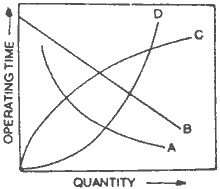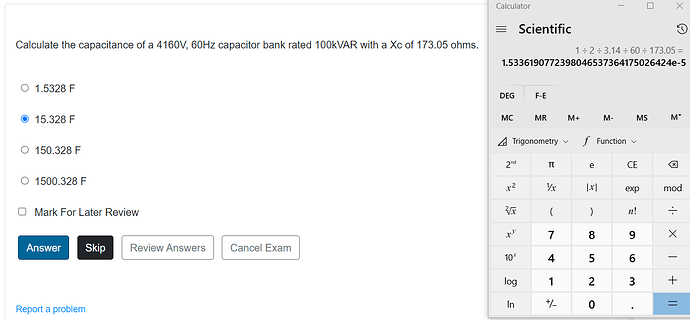Thank you to everyone for your contributions. We have made some corrections based on your comments and continue to grow the database.
2. Which instrument is used to locate a 15kV underground cable fault?
Your Answer: Thumper
Correct Answer: Time domain reflectometer
I’ve always used a thumper in the field but it says a time domain reflectometer is also an option, any clarification would be much appreciated.
thanks
Which curve in the figure shown represents inverse time characteristics?
Your Answer: Curve B
Correct Answer: Curve A
Help: Characteristics of Circuit Breaker Trip Curves and Coordination
Both A and B are inverse time. From IEEE 100:
inverse time (1) (as applied to circuit breakers) A qualifying
term indicating there is purposely introduced a delay in the
tripping action of the circuit breaker, which delay decreases
as the magnitude of the current increases.
(2) See also: inverse-time relay.
…
inverse-time relay A relay in which the input quantity and operating
time are inversely related throughout at least a substantial
portion of the performance range. Note: Types of inverse-
time relays are frequently identified by such modifying
adjectives as “definite minimum time,” “moderately,” “very,”
and “extremely” to identify relative degree of inverseness of
the operating characteristics of a given manufacturer’s line of
such relays.
- Insulating Liquid and Gases
10. What gas would not indicate severe overheating in transformer oil?
Your Answer: Hydrogen
Correct Answer: Ethane
Help: ANSI/IEEE C57.104
Ethane (C2H6) is associated with overheated oil per IEEE C57.104. So is my answer, but less so. I can’t remember the other choices.
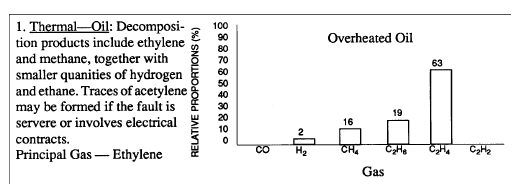
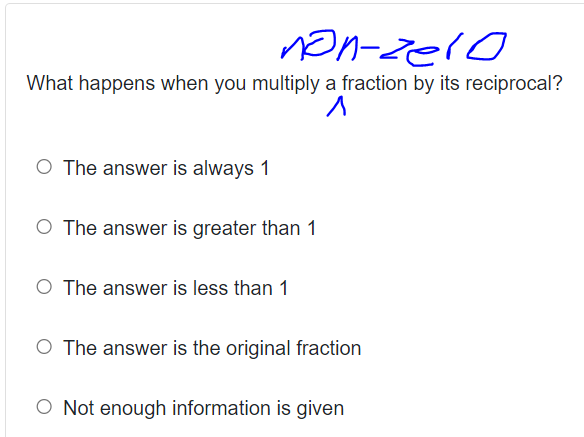
In the question “What happens when you multiply a fraction by its reciprocal?” the answer should be “Not enough information is given.” Not every fraction has a multiplicative inverse, e.g. 0/1.
If you want the answer to be what you claim it is, you should specify “a non-zero fraction.”
Thanks to everyone for your contributions, we are making corrections based on your comments.
According to NEC Section 250.53(A)(2), when is it necessary to supplement a single rod, pipe, or plate grounding electrode with an additional electrode?
Always
a When it has a resistance to earth of 25 ohms or less
b When it is located within a building
c When the electrode is made of concrete-encased steel
it is worded wrong, so no answer is correct. It should be always unless it has 25 ohms or less
What is the major advantage of using the PDC+ technique compared to traditional FDS or conventional PDC techniques in power transformer moisture analysis?
Omicron link is broken. Here is new link.
https://www.omicronenergy.com/download/document/AF464358-176A-4455-A95D-35BCE4880C64/
Where does the highest amount of stress occur in medium-voltage cable?**
Your Answer: At the jacket cut-back
Correct Answer: At the end of the semi-con layer
Help: What Is Electrical Stress?
from supplied link
“The problem arises when we remove the insulation shield for cable splicing and terminating.
The abrupt end to the shield allows the different percentages of voltage to escape the insulation at a concentrated point, creating an area of extreme stress, as the voltage seeks ground/earth.”
Also reference figure “prepared cable end without stress control” from supplied link
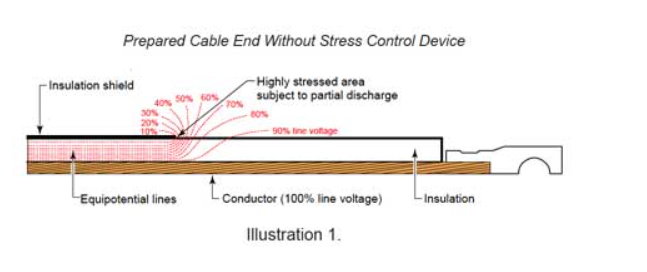
What does OSHA require regarding the testing of rubber safety equipment?
Annual testing for all equipment
Testing before each use
Periodic electrical tests as specified in the regulations
Testing only after repairs have been made
This question is misleading, rubber gloves in particular need to be tested before each use and then electrically tested on a 6 month cycle.
Source: Table I-5, rubber insulating gloves must be tested before first issue and every six months thereafter; and also upon indication that insulating value is suspect, after repair, and after use without protectors. For insulating gloves, the standard clarifies that if the gloves have been electrically tested but not issued for service, they may not be placed into service unless they have been electrically tested within the previous 12 months. However, as explained in OSHA’s [Electrical eTool] under regular use, the best practice is to test gloves as frequently as monthly.
Which sub-section of NFPA 70E requires that employer’s electrical safe work program include a policy on establishing an electrically safe work condition?
Correct Answer: 110.15 (K)
There is no NFPA Section 110.15.
All answers are technically wrong. NFPA reference needs to be changed to 110.5 with the correct being 110.5 (K)
Solar photovoltaic systems, fuel cell systems, wind electric systems, energy storage systems, or interconnected electric power production sources are permitted to be connected to the supply side of the service disconnecting means.**
Your Answer: False
Correct Answer: True
Help: NFPA 70-2017 Section 230.82(6)
Poor wording now with Code language change for 2020. 2017 no longer relevant. For everything mentioned it must also be supplied with its own service disconnect… therefore arguably not “connected” on the line side. 2017 and 2020 language below.
2017
230.82 Equipment Connected to the Supply Side of Service Disconnect. Only the following equipment shall be permitted to be connected to the supply side of the service disconnecting means:
(6) Solar photovoltaic systems, fuel cell systems, wind electric systems, energy storage systems, or interconnected electric power production sources.
2020
(6) Solar photovoltaic systems, fuel cell systems, wind electric systems, energy storage systems, or interconnected electric power production sources, if provided with a disconnecting means listed as suitable for use as service equipment, and overcurrent protection as specified in Part VII of Article 230.
Where isolated metal water piping systems are installed in a multiple-occupancy building, the water pipes can be bonded with bonding jumpers.
Your Answer: False
Correct Answer: True
Help: NFPA 70-2017 Section 250.104(A)(2)
Language of question needs to change. Question implies the pipes would be bonded together. They should not just be bonded together with jumpers but would need to be individually bonded back to the electric equipment supplying that occupancy only.
"
(2) Buildings of Multiple Occupancy. In buildings of multiple
occupancy where the metal water piping system(s) installed in
or attached to a building or structure for the individual occupancies
is metallically isolated from all other occupancies by
use of nonmetallic water piping, the metal water piping
system(s) for each occupancy shall be permitted to be bonded
to the equipment grounding terminal of the switchgear, switchboard,
or panelboard enclosure (other than service equipment)
supplying that occupancy. The bonding jumper shall be
sized in accordance with 250.102(D)."
Thank you everyone for the comments, we are making updates based on the latest contributions.
Which class of termination provides electric stress control and complete external leakage insulation?
Class 1A
Class 1B
Class 2
Class 3
erhhh, answer is technically A, B, and C?
Supporting data quoted from this site.
Class 1 Termination
Provides electric stress control for the cable insulation shield terminus; provides complete external leakage insulation between the cable conductor(s) and ground; and provides a seal to the end of the cable against the entrance of the external environment and maintains the operating design pressure, if any, of the cable system. This class is divided into three types:
- Class 1A: For use on extruded dielectric cable
- Class 1B: For use on laminated dielectric cable
- Class 1C: Expressly for pressure-type cable systems
Class 2 Termination
Provides electric stress control for the cable insulation shield terminus, and provides complete external leakage insulation between the cable conductor(s) and ground.
Class 3 Termination
Provides electric stress control for the cable insulation shield terminus.
What is the minimum acceptable test limit for an ASTM D877 test on mineral oil used in new 69kV equipment?
D877 was removed from the 2021 ATS. 2021 only lists 1816. Does that make this question obsolete?
In what situation is using inhibited oil NOT required in a transformer equipped with an oil preservation system?
Your Answer: When the oil preservation system uses a rubber diaphragm (bladder).
Correct Answer: When the dissolved oxygen level in the oil is below 1000 ppm.
I read the extracted text very different. I believe the article is saying an inhibitor should be used in scenarios where there is an easier exposure to atmosphere. With the GOAL of the inhibitor being to keep the levels under 1000ppm. If its under 1000 ppm the inhibitor is doing its job… but doesn’t necessarily mean it doesn’t need to be there.
I feel like the article is simply saying an inhibitor is not needed in a bladder or active nitro system.
Oxidation Inhibitor And Reinhibiting Oil-Filled Transformers | SDMyers
“In some cases, the transformer may be equipped with an oil preservation system designed to keep dissolved oxygen at a low level (below 1000 ppm). Such a system could be in the form of an active nitrogen system (a nitrogen tank or generator), or a conservator tank containing a rubber diaphragm (bladder). Using inhibited oil is not required in these situations; however, having inhibited oil will provide additional protection against oil oxidation if the oil preservation system were to ever fail.”
Arrange the following PD conditions by severity:
- PD activity is not present or is at sub critical.
- PD activity that indicates a fault is at an advanced stage.
- PD activity that indicates a fault is forming.
It is unclear of what order they are asking for. Highest to lowest, lowest to highest, there could be 2 correct answers here, based on the wording with two different outcomes.
Scores should update immediately but will only be available when you have an active subscription and “Live Hints” are turned off. Otherwise the scores will not be logged.
